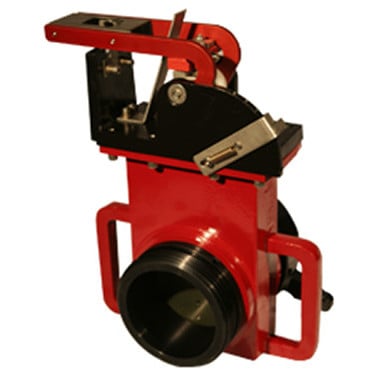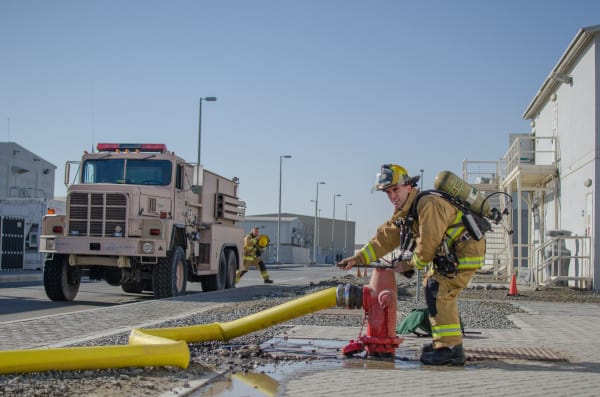Carlin valves, a kind of automatic hydrant gate valve, can prevent damage to the pumper and free up firefighting personnel
When a fire breaks out, one of the first tasks facing the engine company is locating and connecting to a suitable water source. Often, connecting a supply of water to fire engines requires leaving a designated hydrant person behind at a fire hydrant while the rest of the crew proceeds to the scene.
In this article, we look at how an automatic hydrant gate valve known as a Carlin valve can reduce risks to first responders and keep the engine company whole. We begin by explaining the risks associated with hydrant activation and what the hydrant person does. Then, we turn to the design, benefits, and use of Carlin valves.
If you are looking to purchase a Carlin valve, call us at +1 (888) 361-6662 or email support@qrfs.com.
The hydrant person controls fire hydrant activation and prevents damage to piping and firefighting equipment
A few things might happen when firefighters arrive at the scene of a fire: first, the engine stops at a nearby hydrant, where one firefighter – the hydrant person – gets off the truck. This person secures one end of a supply hose to the hydrant, often by looping it around the hydrant’s base or connecting it to the hydrant with a strap.
Then, the hydrant person opens the hydrant, flushes out the debris, and closes the hydrant again. In the meantime, the engine advances toward the scene, dropping hose behind it. The firefighter at the hydrant connects the hose to the hydrant and waits for the signal to flow water. This video shows how this individual has to stay behind:
One critical task facing the hydrant person is flow control. Firefighters start and stop hydrant flows gradually because sudden changes can damage hydrants, fire engines, and other equipment. Ultimately, this is because water lacks compressibility: when a pipe or other water-filled container is placed under pressure, the water inside doesn’t become (much) more compact. Instead, it prefers to move elsewhere, surging through the pipes, flowing through an open orifice, or bursting through weak spots in the pipe.
These sudden increases in pressure within piping systems are known as hydraulic transients, pressure surges, or simply “water hammer.” When a valve suddenly opens or closes, the sudden movement of water inside can deform or even break pipes and other fittings.
At fire hydrants, water hammer can prove costly and even dangerous. The most common problem is that shockwaves from quick hydrant closure cause the water mains supplying the hydrant to break, impairing firefighting operations and causing flooding. But these shocks can also travel between the hydrant and pumping equipment, injuring nearby firefighters or damaging equipment. In this news clip, we see some of the possible effects of water hammer; in this case, multiple burst pipes that shut down several nearby fast-food joints:
Carlin valves open at a controlled rate, allowing the hydrant person to stay with the engine while preventing water hammer at the pumper
Carlin valves can prove helpful when water hammer from the hydrant to the pumper is a concern – or when engine companies can’t afford to spare even a single firefighter. The Carlin valve, a type of automatic hydrant gate valve, installs between a fire hose coupling and a hydrant outlet to control the flow of water.

Carlin valves manage water flows using a sliding gate: a disc raised or lowered into the path of water flow. Early on, this gate remains only partially opened. As a result, the hydrant side of the valve fills quickly, while the fire hose fills gradually. Closing the other end of the hose allows it to fill completely, creating equal water pressure on both sides of the gate. At that point, the water inside the hose pushes the gate up fully, opening the valve.
These automatic hydrant gate valves can greatly simplify the task facing the hydrant person. A Carlin valve – in the closed position – and a supply hose are attached to the fire hydrant. The hydrant person pulls a length of hose from the engine and quickly opens the hydrant. After verifying that the hydrant is flowing water, the hydrant person can activate the valve, adjust the flow rate, and return to the fire engine.
After that, firefighters travel to the fire scene. The other end of the hose is closed off using a suction inlet valve, portable distribution manifold, or an approved hose clamp. Then, when the hose fills with water, the Carlin valve opens, allowing the hydrant to flow freely.
Built on a simple mechanical principle, the Carlin valve offers reliability and several other benefits
Carlin valves aren’t the only kind of hydrant gate valve available, or even the only automatic type. Some remote-controlled hydrant gate valves offer comparable benefits with remote or radio-controlled gates. But while other automatic flow-retarding valves may rely on battery power, springs, or other mechanisms to raise the gate, the Carlin valve operates on a much more straightforward principle: hydraulic displacement. When both sides of the Carlin valve’s gate reach an equal pressure, water lifts the gate out of the path of water flow.
But reliability isn’t their only benefit: Carlin valves also reduce human error, preventing flows from starting too fast or too soon. And while they don’t address the problem of water hammer from the hydrant to the water mains, their slow-filling design greatly reduces the likelihood of pressure surges between the hydrant and the pumper. Further, water enters supply hose as the engine advances, adding extra weight that can prevent twisting or snaking of the hose.
The Carlin valve can also prevent situations where hose is laid from a dry or inoperative hydrant. The engine stays with the hydrant person until the hydrant is opened, allowing the hydrant person to verify whether water is flowing and disconnect the supply hose and immediately return to the engine if a problem is discovered. Carlin valves also allow firefighters to control hydrant flow from the pumper. Because this hydrant gate valve remains partially opened until pressure equalizes, firefighters can remotely activate the hydrant simply by closing off the end of the hose opposite the hydrant.
Carlin valves adjust to meet the specifications of particular hoses and hydrants
Flowing too much water into the supply line too quickly can cause water to fill the hose before it leaves the hose bed, while filling too slowly can delay firefighting operations. As a result, each Carlin valve must be calibrated at least once before being placed into service. By adjusting the flow rate for a specific hydrant, hose type, and hose length, these automatic hydrant gate valves can provide the safety and speed needed at the fire scene.
As an example, we’ll look at the Model CV45A Carlin valve from Fyrelane USA, a Texas-based manufacturer of fire protection products. While these steps won’t be the same for each valve, the company’s manual shows a helpful checklist of calibration steps:
- Prepare the Carlin valve for calibration. Attach the Carlin Valve to 100 feet of hose of the same size and type that will be used. Connect the Carlin Valve to the hydrant. Close the other end of the hose with a cap, hose clamp, or a closed pumper intake valve.
- Begin flowing water. The cam lever controls the valve’s fill rate, while the stop lever prevents the cam lever from opening too far. Set the stop lever in the middle position. Then, fully open the hydrant. Release the safety catch and move the cam lever to the same position as the stop lever.
- Measure hose filling time. Fyrelane’s documentation recommends a 30-second fill rate for 100 feet of hose. The gate will fully open a few seconds after the hose has fully pressurized.
- Adjust the fill rate. Close the hydrant and bleed the hose. To increase the flow rate, take the shims from the top of the gate-shaft lever and place them on the underside. To decrease the flow rate, remove shims from the bottom of the lever. Empty the hose and repeat the previous steps as needed to reach the proper fill rate.
- Arm the valve. After determining the desired setting, close the hydrant, bleed the hose, and remove the Carlin valve from the hydrant. Push the gate shaft lever down until it reaches the roller and lock it in place by latching the cam lever under the safety catch.
Add a Carlin valve to your firefighting arsenal
QRFS is proud to distribute Carlin valves from Fyrelane USA, a manufacturer with four decades of experience producing equipment for water-based systems. Their selection includes Carlin valves for the most common hydrants and hoses – including 4″ and 4 1/2″ National Standard Thread (NST) and 4″ and 5″ Storz couplings – and custom sizes by special order.
With an adjustable discharge rate, automatic activation, and a wide range of replacement parts readily available, these American-made hydrant gate valves are designed to put your hydrants, engines, and fire professionals to good use.
Let QRFS help you find the Carlin valve for your needs – call us at +1 (888) 361-6662 or email support@qrfs.com.
This blog was originally posted at blog.qrfs.com. If this article helped you make an informed decision about Carlin valves, check us out at Facebook.com/QuickResponseFireSupply or on Twitter @QuickResponseFS. Source for image at the top of this post: US Air Forces Central Command.


